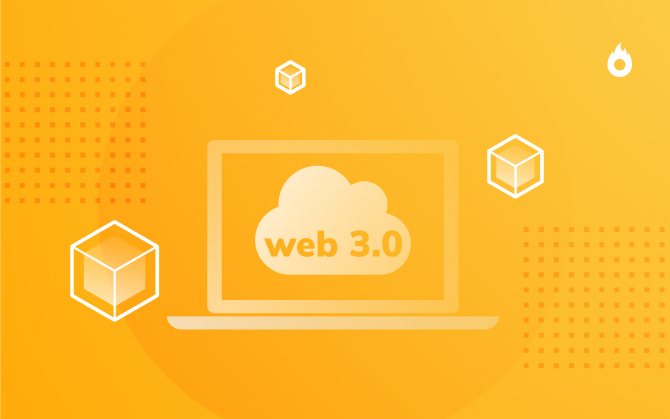
Web3 Content Creation: The Biggest Trends To Watch For
It's not just about the product or service you offer; it's about the experience, community, and sense of fulfillment surrounding your product or experience.

Have you ever wondered what is web3 and why it matters? We explain to you. Web3 is a decentralized Internet in which people hold more individual power over websites, content, and so on and are not at the mercy of a few large governing bodies.
Keep reading to learn more!
Web3 content creation and the history of the Internet
To understand Web3 and how to make the most of it, we need to take a step back and look at the Internet itself from a big-picture perspective.
Ultimately, the Internet is about information: the creation, distribution, and consumption of information at an increasing scale. People take in information from the Internet, which adds value to their lives. People go to the Internet to be informed, entertained, enlightened, connected with others, and much more.
If you look at the Internet in terms of who creates the information, controls the information, and consumes the information, the history of the Internet can be essentially divided into three stages.
What was Web1?
First, the Internet that was introduced to the world in the 1990s was an Internet that supplied information to consumers, much as essentially a conglomerate of digital newspapers.
This information was created by and controlled by corporations. At the same time, the Internet started mainly as a source for news, into evolved into other functions such as allowing users to purchase products and services. The content on the Internet was completely controlled and regulated by corporations, and users of the Internet did not themselves create or distribute any content. Some people call this original version of the Internet “Web1.”
What about Web2?
As the Internet evolved, there were more opportunities for people using the Internet, not just big corporations, to create and share their content. Thus, sites like YouTube and MySpace became famous as a way for people to build their content, express themselves, and share with the world.
This version of the Internet in which both corporations and people create content on the Internet is called Web2, the version of the Internet we all use now. While people create an immense amount of content every day on this version of the Internet, the content they make is still under the authority and control of large corporations, which filter, monitor, and ultimately have the final say over the content being distributed.
And now: web 3!
A growing movement is now creating a third iteration of the Internet called “Web3,” in which content will not be ultimately at the mercy of a few vast corporations but will be more democratic and spread across millions of users worldwide. In other words, Web3 is a decentralized Internet in which people hold more individual power over websites, content, and so on and are not at the mercy of a few large governing bodies.
View this post on Instagram
How can companies and content creators harness the power of Web3?
First, it’s important to remember that Web3 will create an entirely different communications experience between sites and users from anything we’ve seen.
Web3 will be primarily a “semantic” network of information, meaning that people will communicate in the regular language with websites. Still, instead of waiting for an email from a customer service representative, for example, websites will be able to use natural language processing and AI models to communicate with and meet the needs of consumers.
From a marketing standpoint, this is incredibly significant, allowing you to operate at a significant scale and speed with customers. It will give you the ability to program and build customer experiences that generally would require interaction with another human being.
Another significant advantage Web3 will have for marketers, which is already somewhat coming into play, is 3-D technology. As VR becomes more popular as well, marketers can utilize 3-D and projection technology to enable customers to have a more immersive experience with their products or services. When combined with AI’s natural language processing capabilities, this will be a race for companies to determine who can create the most immersive experience possible for customers.
Web3 content creation and the Metaverse
View this post on Instagram
As the metaverse expands, Web3 will allow customers to fully explore digital worlds and environments and buy things like NFTs and personal space in these environments to create ownership.
As a company, you may be able to harness the Web3 metaverse to create virtual experiences for customers that allow them to explore digital offerings in a simulated space, turning some of what you offer into a kind of video game in some applications.
And customers will be able to try and experience products and services, explore completely digital storefronts and streets, for lack of a better term, with your digital locations, and much more. The offerings of the metaverse are essentially infinite, and we’re just now tapping into what’s possible.
A transformation in building a community with Web3 content creation
More customers than ever care about online communities, and the Web3 environment will make online communities centered around a brand or company more immersive than ever. The decentralized nature of Web3 means that communities can come together and build their content, infrastructure, community rules, voting rights, and other digitally democratic elements that will set Web3 apart.
Companies will be able to create things like social tokens and digital contracts that help people feel ownership and connection to each other and to the brands they love. The decentralized Web3 will create more online privacy and give people more ownership. Once it becomes a more significant trend, the influence of major players transitioning to Web3 will be overwhelming.
This will be a significant step from anything we’ve seen regarding community building for brands and marketers. And we’re just scratching the surface, once again.
Web3: the future of the Internet has never been brighter
The key here is that Web3 is about democratizing data, control, and immersive user experiences.
It’s not just about the product or service you offer; it’s about the experience, community, and sense of fulfillment surrounding your product or experience. Creating ownership for consumers and prospects is paramount.
Anyway, you can utilize Web3 to help others feel a sense of ownership and community around what you offer, and the better you’ll be. This is precisely what Web3 will help facilitate.
And if you want to learn more about the biggest trends for the future when it comes to education, be sure to check out this blog post from Hotmart’s CEO.
View this post on Instagram





